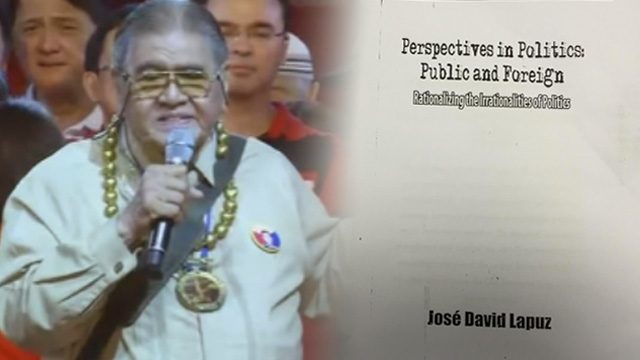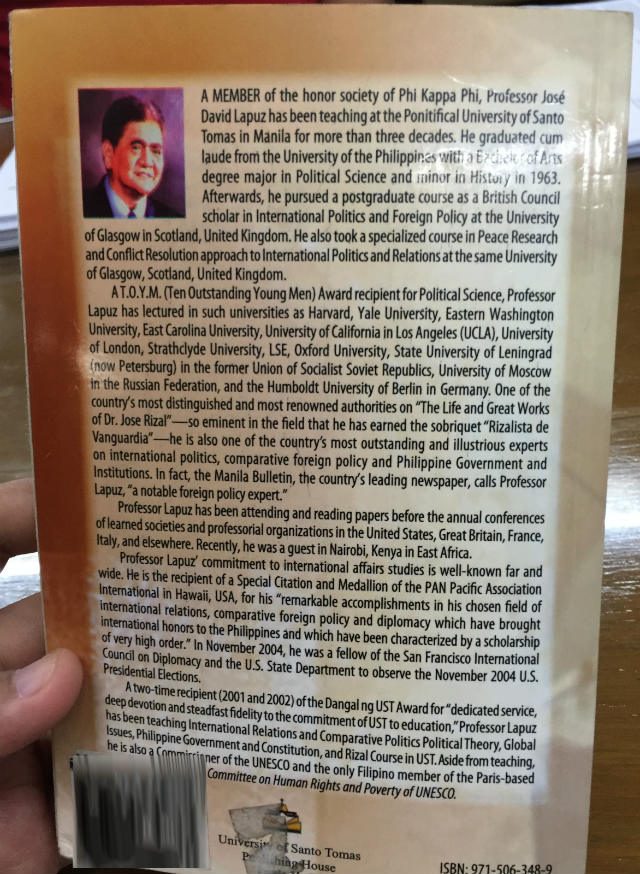SUMMARY
This is AI generated summarization, which may have errors. For context, always refer to the full article.

MANILA, Philippines – Did Jose David Lapuz – the former professor of President Rodrigo Duterte who is reportedly in the running to head the Commission on Higher Education (CHED) – plagiarize?
It appears so, according to editors of an academic journal who showed Rappler a matrix that details plagiarized content of Lapuz’s book, Perspectives in Politics: Public and Foreign; Rationalizing the Irrationalities of Politics.
The book is a compilation of Lapuz’s articles and speeches delivered or published in newspapers throughout the years. It was published in 2005 by the University of Santo Tomas (UST) Publishing House.
Text was lifted, without attribution or acknowledgment of the original source, from various books and articles, primarily authored by international academicians.
Plagiarism, as defined by the Oxford English Dictionary, is taking someone else’s work or idea and passing it off as your own.
Several personalities had been placed under the spotlight in the past after reportedly committing plagiarism.
Among them was Senator Vicente “Tito” Sotto III, who went under fire for two acts: using a translated part of a speech by former United States Senator Robert Kennedy without attribution, and lifting parts of his speech that opposed the reproductive health (RH) bill from a health blogger.
Former Supreme Court Justice Mariano del Castillo was also accused of plagiarizing parts of his decision, lifting text from a controversial case involving World War II comfort women in 2010. He, however, was cleared of any liability.
Tainted articles

The academic journal’s editors, who had been involved in checking for plagiarism for 3 to 5 years, pointed out that at least 20 articles out of the 61 compiled in Lapuz’s book “are tainted with plagiarism.”
The compiled articles touched on various subjects under politics and foreign affairs, Lapuz’ field of expertise as stated in his curriculum vitae.
According to the sources, who requested anonymity, Lapuz “hacks away chunks of texts, at times an entire page, from certain authors and stitches these to his supposed work.”
Since last week, Rappler has been trying to get the side of both Lapuz and the UST Publishing House. Messages were sent via Lapuz’s Facebook Messenger, which he had seen, but which he ignored. Lapuz’s Facebook page has been active based on his frequent posts during the period we were trying to reach him. Rappler also sent a letter via email on Monday, July 18, but got no reply.
On July 24, Lapuz sent a letter taking full responsibility.
“Definitely and unquestionably, failure to identify the source of borrowed text is unallowable,” he added. “But still, human being (sic) commit slip errors; they carry out flubs and mistakes. Blundering fools we are.”
The UST Publishing House, meanwhile, acknowledged on July 12 the request to get their side and notified us the letter had been forwarded to the Office of the Director. On July 13, after a follow-up request, the publishing house said they are “taking this under advisement” or studying the issue and would contact Rappler “when they are ready.”
We repeatedly followed up on Friday, July 15, and Monday, July 17. No reply has been given to date.
We double checked the entirety of the book, and arrived at the same conclusion. Lapuz failed to include citations of original sources in parts of his book.
For example, a paragraph in an article entitled “Foreign Policy Objectives: Towards a Framework of Dignity” was lifted and hardly altered, sans citation, from International Relations: The Global Condition in the Late Twentieth Century published in 1984.
| LAPUZ’ TEXT | ORIGINAL TEXT |
| Foreign Policy Objectives: Towards a Framework of Dignity (page 43) | International Relations: The Global Condition in the 20th Century (Page 97 to 98) |
| “A nation’s image of itself and of others is shaped not only by specific historial events but even more so by cumulative or increscent historical experiences as retold in family gatherings or in the civics, history textbooks to which all children are exposed in school.“ | “Kenneth Boulding has noted that a nation’s image of itself and of others is shaped not only by specific historial events such as Munich (which may affect only the generation that lived through them) but even more so by cumulative historical experiences as retold in family gatherings or in the civics textbooks to which all children are exposed in school.” |
Parts of a paragraph in Sovereignty as a Basis for Foreign Policy have similiar text from Frederick Hartmann’s 1983 book, The Relations of Nations.
Upon checking, some words found in Lapuz’s piece were identical to the original words in Hartmann’s.
| LAPUZ’S TEXT | ORIGINAL TEXT |
| Sovereignty as a Basis for Foreign Policy (page 26 to 27) | The Relations of Nations by Frederick H. Hartmann (page 68, published in 1983) |
| “Principles of foreign policy consist of selected national interests presumably formulated into a logically consistent whole that is then implemented. And foreign policy can be viewed analytically in three angles: conception, content, and implementation. Conception involves strategic appraisal of what goals are desirable and feasible. Content is the result and reflection of that appraisal in terms of a particular selection of national interests. Implementation looks to both the coordinating mechanisms within a state and the means by which it conveys its views and desires to other states.” | “Because a foreign policy consists of selected national interests presumably formulated into a logically consistent whole that is then implemented, any foreign policy can be viewed analytically in three phases: conception, content, and implementation. Conception involves the strategic appraisal of what goals are desirable and feasible, given the presumed nature of the international system. Content is the result and reflection of that appraisal. Implementation looks to both the coordinating mechanisms within a state and the means by which it conveys it views and wishes to other states. Although inefficiencies and failures can be very costly in any of these three phases, it is apparent that the most critical phase is conception.” |
Failing to explicitly identify the source of borrowed text or idea already constitutes plagiarism.
Outside the 20 articles initially identified by the editors of the academic journal, Rappler found two more instances where text bear strong resemblance to other works that were not by Lapuz.
At least 5 paragraphs in Lapuz’s article, “Reflections, or Thoughts Coming in of the Tide” came from a 1990 article published in the Los Angeles Times and written by Barry Wood.
| LAPUZ’ TEXT | ORIGINAL TEXT |
| Reflections, or Thoughts Coming in of the Tide (page 270) | A Stroll Down Unter den Linden Takes Visitors Into the Soul of Berlin (by Barry D. Wood, published on May 13, 1990) |
| “I can picture Rizal, as narrated in his letter, sauntering leisurely (in characteristic European unhurried manner) through Unter den Linden (“under the linden trees”) which was designed in the 18th century as a grander, Prussian answer to Paris’s Champs Elysees. From the now destroyed, monumental Brandenburg Gate, I retraced those footsteps of Rizal as the Linden sweeps east past ornate, florid palaces, churches, and theaters to the famous Spree River, where it was once crowned by the mammoth palace of the Prussian kings. The imperial palace, older and larger than London’s Buckingham Palace, was massively damaged in World War II. East Germany’s communist rulers bulldozed its remains from the equivalent of two square blocs in the early 1950s and constructed the glaring, amber glass Placade of the Republic, which houses the parliament of Volkskammer. Since the Wall was breached on November 9, 1989, the Linden has sprung back to life with antonishing, amazing speed. The enforced grayness of the Stalinist past diminishes daily. Strollers and visitors again crowd the center walkway beneath the linden trees capped by fragrant, cream-colored flowers. Big West German BMWs and Mercedes Benzes roar up the Linden past sputtering and confusedly rapid East German Trabants and Wartburgs, which already seem an oddity, a queer fish, or that which is a left-over look. Initially, visitors came east out of curiousity, or because they were excited by its strangeness. Now they increasingly come in what I call a spiritual and ethereal quest to tap into Berlin’s rich history. For the first time since 1961, West Germans can walk through the six pillars of Brandenburg Gate, which is covered with scaffolding for a long-delayed refurbishing and reconditioning. Gone, too, for restoration from atop the gate is the Quadriga, the chariot of victory that Napoleon liked so much in 1806 that he took it back to Paris. Otto von Bismarck brought it back in 1870, the year he made Berlin the capital of unified Germany. The Prussian king became the General emperor, or kaiser… …For the first 200 years there is little but concrete and empty space where the pillboxes, bobby traps and guard towers stood so recently. Past the first intersection, what was the once elegant Wilhemstrasse, is the massive and imposing Soviet embassy. The adjacent French and British embassies, as well as the notable Adlon hotel were all lost in World War II.” |
“Unter den Linden (“under the linden trees”) was designed in the 18th Century as a grander, Prussian answer to Paris’s Champs Elysees. From the monumental Brandenburg Gate, the Linden sweeps east past ornate palaces, churches and theaters to the Spree River, where it was once crowned by the mammoth palace of the Prussian kings. The imperial palace, older and larger than London’s Buckingham Palace, was massively damaged in World War II. East Germany’s Communist rulers bulldozed its remains from the equivalent of two square blocks in the early 1950s and put up the glaring, amber glass Palace of the Republic, which houses the parliament or Volkskammer. It and the adjacent, similarly modernist Foreign Ministry are discordant buildings, woefully out of harmony with their 18th- and 19th-Century surroundings. Since the Wall was breached last Nov. 9 the Linden has sprung back to life with astonishing speed. The enforced grayness of the Stalinist past diminishes daily. Strollers again crowd the center walkway beneath linden trees that were planted after World War II and are often no bigger than dogwoods. Big West German BMWs and Mercedes Benzes roar up the Linden past sputtering East German Trabants and Wartburgs, which already seem oddly out of place… Initially, the Westerners came east out of curiousity. Now they increasingly come in what some call a spiritual quest to tap into their city’s history, hoping to reclaim its standing as Germany’s unchallenged cultural and artistic center. For the first time since 1961, West Germans (but not foreigners, who must still go through official border posts) can walk through the six pillars of Brandenburg Gate, which is covered with scaffolding for a long-delayed refurbishing. Gone, too, for restoration from atop the gate is the Quadriga, the chariot of victory that Napoleon liked so much in 1806 that he took it back to Paris. Bismarck brought it back in 1870, the year he made Berlin the capital of a unified Germany. The Prussian king became the German emperor, or kaiser… For the first 200 yards there is little but concrete and empty space where the pillboxes, booby traps and guard towers stood so recently. Take in this barren wasteland soon, because a land rush is on and much of this choice real estate from here south to Potsdamer Platz is likely to be sold off soon for development. Past the first intersection, what was the once-elegant Wilhelmstrasse, is the massive Soviet embassy, which the 1904 guidebook identifies as merely the Russian legation. The adjacent French and British embassies, as well as the notable Adlon hotel, were all lost in World War II.” |
Meanwhile, the first paragraph of Lapuz’s Christmas-themed article, “Glory to God in the Highest, and on Earth Peace to the World of Nations,” came from the Saint Joseph Daily Missal in 1956.
| LAPUZ’ TEXT | ORIGINAL TEXT |
| Glory to God in the Highest, and on Earth Peace to the World of Nations (page 127) | Saint Joseph Daily Missal (1956) |
| “The contemplation of the mystery of Christmas – the mystery of Incarnation – invites us to be born again through a more vital union with Jesus Christ who became man for us. With the Magi we ought to thank God for manifesting Himself to us. We should walk like the Three Wise Men with a lively, sparkling faith, ever seeking the true God and longing for His heavenly gifts.” | “The contemplation of the Mystery of the Incarnation invites us to be born again through a more vital union with Jesus Christ Who became Man for us. With the Magi we should thank God for manifesting Himself to us. We should walk like them with a lively faith, ever seeking the true God and longing for His heavenly gifts.” |
It is important to note too that Lapuz also republished the above-questioned article in December 2015 in the Manila Bulletin.
The title, however, was changed to “International peace, supra-national government, and the goal of hope, happiness, and well-being in the world of nations,” with no note mentioning it had been published beforehand. This can be considered self-plagiarism.
According to iThenticate’s The Ethics of Self-Plagiarism, self-plagiarism is a “type of plagiarism in which the writer republishes a work in its entirety or reuses portions of a previously written text” presenting it as new work.
Requirement of integrity

This is not the first time that Lapuz has been called out for his blunders.
After reports said he had been chosen to become the next CHED chairperson, his former students came out and said Filipino students “deserve better.” (READ: Lapuz as CHED chair riles former students)
His students in Rizal and political science courses said they did not learn anything during the entire the semester and “only wasted tuition.”
Although the criminal liability of plagiarism is highly contested, it is no doubt an unethical act.
The University of the Philippines, for instance, in its 2012 Student Code, says plagiarism is an act of academic dishonesty. A student found to have plagiarized may be suspended for one semester or expelled.
Although there is no direct liability, personalities who had been tagged in plagiarism cases usually took responsibility.
For instance, businessman Manuel V. Pangilinan, after committing plagiarism in a graduation speech in 2010, stepped down as chairman of the board of the Ateneo de Manila University. (READ: MVP, Sotto, and plagiarism)
Republic Act Number 7722 explicitly says that the CHED chairperson and commissioners should be “academicians known for their high degree of professionalism and integrity.”
Lapuz’s supposed designation as CHED chair was announced on June 13 by Ateneo de Davao University president Joel Tabora, SJ, in his blog. Lapuz eventually confirmed this in an open letter posted on his blog, saying that his CHED designation, which covers both public and private higher institutions in the Philippines, is a dream come true.
Duterte, who was Lapuz’s political science student at the Lyceum of the Philippines University in the 1960s, has yet to confirm Lapuz’s appointment.
In addition, the term of incumbent CHED Chair Patricia Licuanan will not expire until 2018. She was appointed in 2010 and again in 2014 by then President Benigno Aquino III. RA 7722 says the CHED chairperson shall hold office for 4 years per term.
Will Lapuz still get the CHED appointment? – Rappler.com
Add a comment
How does this make you feel?
There are no comments yet. Add your comment to start the conversation.